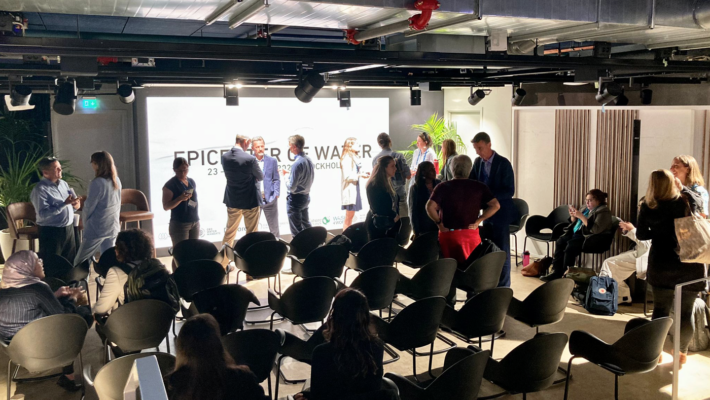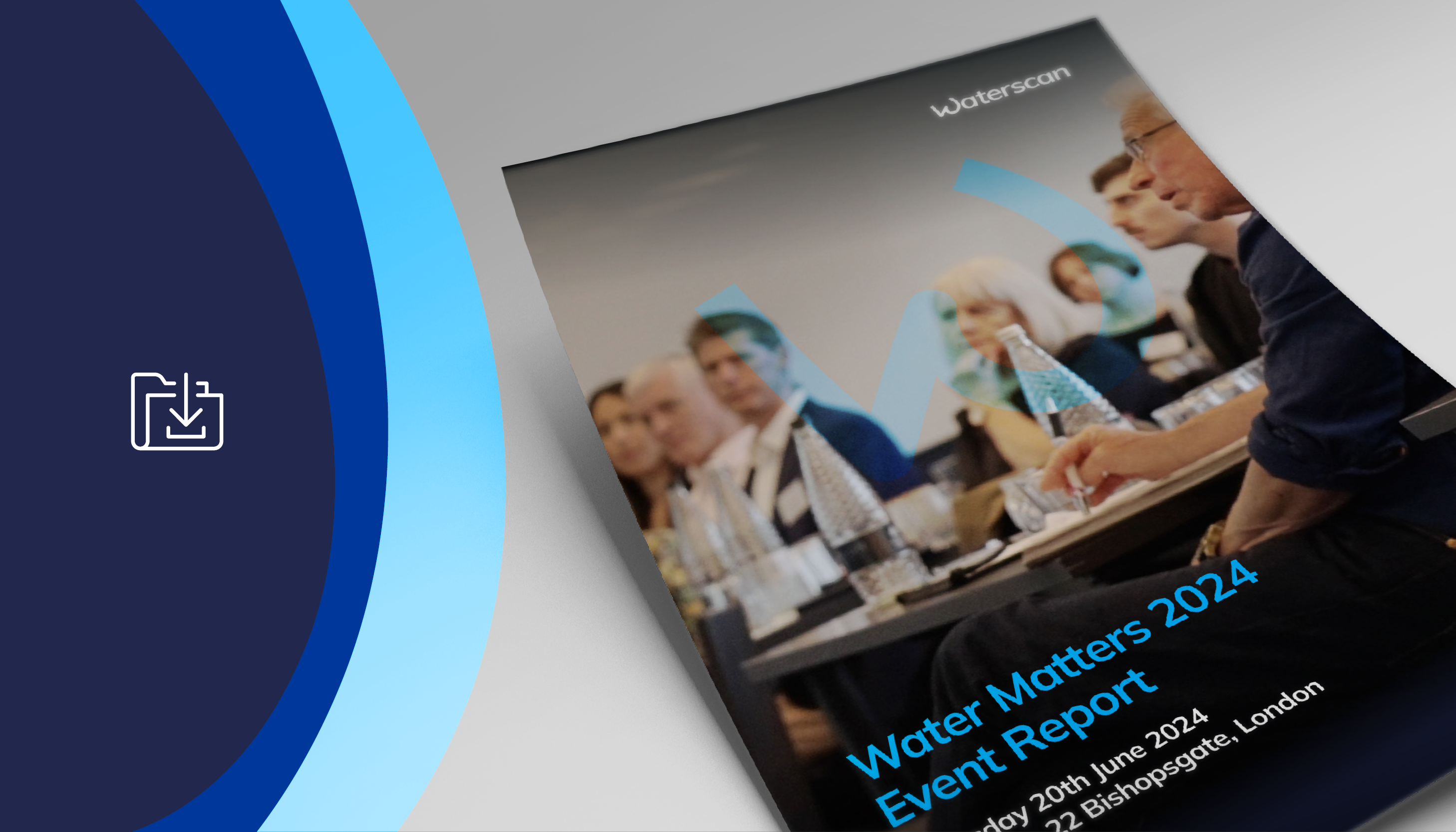In conversation with Rebecca Gale and Esmond Bowerman.
The message coming out of Stockholm as World Water Week concluded last month was that there is ‘a clear global determination to find innovative solutions to complex water challenges’. With 15,000 participants representing nearly 200 countries and territories, the attendee numbers appear to support this.
But what’s actually happening on the ground, here in the UK? Are British companies content with talking about water, or are they already acting to secure a water-resilient future? Waterscan’s Rebecca Gale, Account Director, and Esmond Bowerman, Sustainability Manager, offer their insights.
All the talk around needing to accelerate action on water at Stockholm recently is encouraging, but also overdue. In your experience, why do you think that many companies haven’t embraced water as a core sustainability pillar before now?

Rebecca: “Often, the fundamental barrier is that, even though the intention might be there, many companies simply don’t know where to begin. The whole topic of water can be quite overwhelming, and inconsistent, inaccessible terminology used across the sector fuels that. Do we have a common understanding of what we mean by ‘water footprinting’ or ‘water neutrality’, for example? Which reporting and disclosure framework will be most useful, and then, what data is needed to comply and how do you get it? Do you begin with direct operational impacts or tackle supply chain at the same time? What will have the most impact in driving down business risk whilst also creating environmental and societal value? There’s a complexity to water that traditionally generates more questions than answers. So, unless water stewardship is a regulatory, safety or commercial priority, it tends to slip down the action list.
I have also seen a great deal of duplicated effort recently, with various stakeholders and market players – customers/retailers/wholesalers/councils, for example – all trying to do the right thing but approaching it in uncoordinated ways, wasting valuable time, money and resource. We need to upweight collaboration and information sharing between parties to achieve maximum impacts.”
Esmond: “Water is cheap. It has relatively little impact on the bottom line – that is unless things go wrong. Until all businesses appreciate the true value of water and they cost in their use of this natural capital, the economic ramifications of water use are unlikely to be a corporate priority.
It’s also quite unlike carbon or plastics; you can’t simply offset your emissions or reverse engineer packaging to solve the problem. Water is context dependent, and location matters in finding solutions and mitigating impacts. There’s no universal solution which is why expert support is invaluable to achieve best results.”
So, how can these barriers to action be overcome?

Esmond: “Following initiatives like TCFD, there are standardised ESG reporting frameworks for financial entities like investors coming into play across the UK, EU and USA over the next couple of years. These should catalyse action – regulatory demands are usually the starting point and many companies like to be ahead of incoming regulation. But multinational companies and those with complex global supply chains, be warned! – there’s unlikely to be a consistent approach across them. In my mind, simplifying and standardising the language used around water will make it a lot easier for corporate boards to understand, firmly align water with existing values and visions and wider sustainability agendas and highlight the positive opportunities that arise from sound water management.”
Some companies are well ahead of regulation. Which companies currently stand out to you as leading the way?
Rebecca: “Three companies immediately standout to me. Sainsbury’s whole approach, and in particular, what the company is doing to achieve water neutrality by 20401, is potentially game-changing.
Whitbread has made an impressive commitment too: to cut water consumption by 20% per sleeper within its Premier Inn chain, by 20302. Not only is this a significant demand reduction nationally but the strategy for achieving these numbers is based on identifying and prioritising water stressed areas.
Finally, I’d like to call out The Coca-Cola Company, which started working on its water strategy in 2004. Since then, the company has blended voluntary disclosure with initiatives like water replenishment, partnerships with The Rivers Trust and WWF, and has data-led site-specific targets, niche to operational environments.”
Disclosure leaders CDP, says it is working to reposition water, highlighting opportunity rather than risk, and framing the need for action in the positive, rather than the negative. What’s your view on the likely impact of this approach?
Rebecca: “In principle, I agree because there are so many positives arising from sound water stewardship but I think it depends on who you’re talking to. With consumers, it appears that there’s a real disconnect between understanding the issue and changing behaviour. A recent study by the Consumer Council for Water3 concluded that there was little consensus over the types of messages that are more likely to encourage people to take action: some people react better to gloomier messages and others to happier ones, so a careful balance is needed to communicate both ‘why’ and ‘how’ to save water.
However, in a business context, I’m not entirely convinced. Businesses respond to risk frameworks: they need to know what risks exist in their business and how to mitigate them. In this scenario, it’s becoming increasingly urgent to portray the material risk of water to businesses continuity. While there are certainly positive opportunities arising from acting on water, it’s important not to beat about the bush about the negative implications of inaction, too. Most companies have excellent governance structures in place so they’re really good at fixing problems when they arise: unfortunately, many simply do not regard water as a problem.”
Esmond: “Not enough is made of the opportunities arising from strategic water management. CDP estimates that return on investment in water-related projects could be as high as 2:1, but I think it’s important to stress the value not just in reducing costs, but in making a positive difference to the locations in which you do business. I think a strong message is that working on water amplifies work on other environmental concerns.”
Where’s the best place for a company to start its water stewardship journey?
Esmond: “As always, it’s important to first understand your position fully with sound data and actionable insight. Then, work for incremental improvement; there’s no point in creating a ‘bells and whistles’ strategy that may or may not be achievable. Focusing on one high-priority catchment area could achieve much more than a vague approach across many. I also advocate engaging with local communities to supplement understanding derived from data, and working with them to create and test action plans.”
Rebecca: “I completely agree, and would add that finding quick wins are important in almost all cases. As we all know, it can take many, many months to get formal strategies and pledges approved, but in the meantime, available water and business resilience continue to decline. Quick wins build momentum, create key learnings specific to organisations, and importantly, generates a narrative around water in dialogues with suppliers and other stakeholders for further impetus.”
To find out more about some of our customer’s water journeys, including Sainsbury’s, Whitbread and The Coca-Cola Company, please take a look at our ‘Customer insights‘ section of the insight hub.
References:
1 – Water neutrality at Sainsbury’s – Sainsbury’s (sainsburys.co.uk)
2 – Whitbread targets 20% reduction in water usage per guest by 2030 – Whitbread PLC
3 – CCW: Gloom And Bloom – Measuring Emotional Engagement With Water-saving Messages, July 2023




